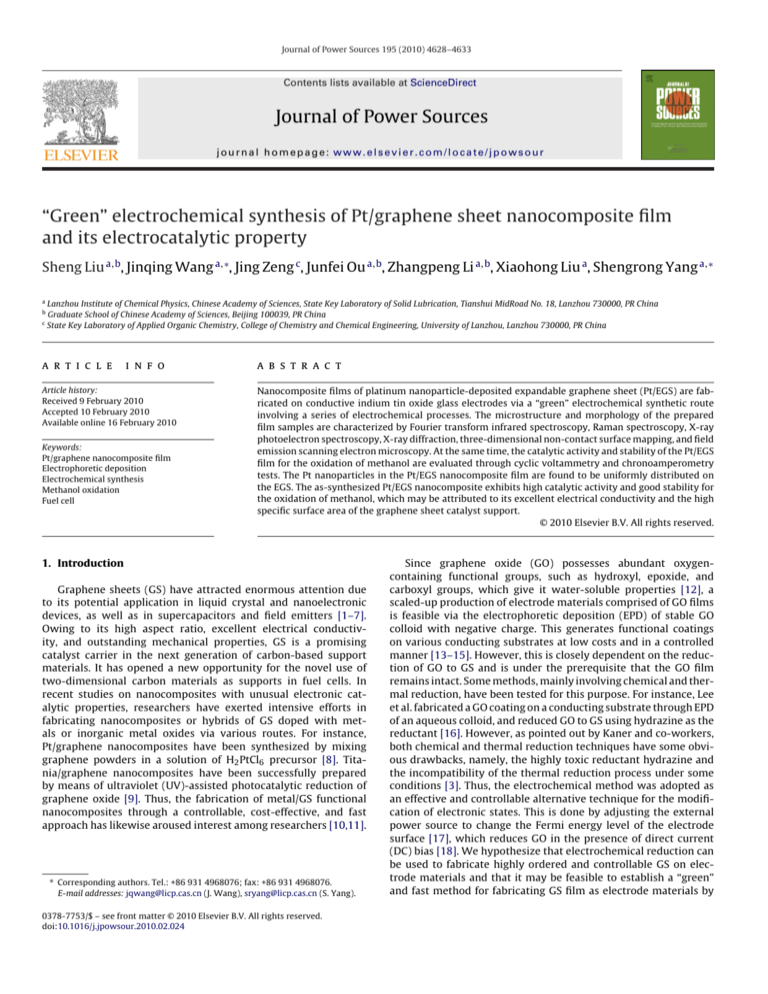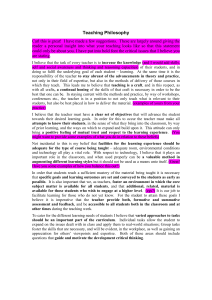
Journal of Power Sources 195 (2010) 4628–4633
Contents lists available at ScienceDirect
Journal of Power Sources
journal homepage: www.elsevier.com/locate/jpowsour
“Green” electrochemical synthesis of Pt/graphene sheet nanocomposite film
and its electrocatalytic property
Sheng Liu a,b, Jinqing Wang a,∗, Jing Zeng c, Junfei Ou a,b, Zhangpeng Li a,b, Xiaohong Liu a, Shengrong Yang a,∗
a
b
c
Lanzhou Institute of Chemical Physics, Chinese Academy of Sciences, State Key Laboratory of Solid Lubrication, Tianshui MidRoad No. 18, Lanzhou 730000, PR China
Graduate School of Chinese Academy of Sciences, Beijing 100039, PR China
State Key Laboratory of Applied Organic Chemistry, College of Chemistry and Chemical Engineering, University of Lanzhou, Lanzhou 730000, PR China
a r t i c l e
i n f o
Article history:
Received 9 February 2010
Accepted 10 February 2010
Available online 16 February 2010
Keywords:
Pt/graphene nanocomposite film
Electrophoretic deposition
Electrochemical synthesis
Methanol oxidation
Fuel cell
a b s t r a c t
Nanocomposite films of platinum nanoparticle-deposited expandable graphene sheet (Pt/EGS) are fabricated on conductive indium tin oxide glass electrodes via a “green” electrochemical synthetic route
involving a series of electrochemical processes. The microstructure and morphology of the prepared
film samples are characterized by Fourier transform infrared spectroscopy, Raman spectroscopy, X-ray
photoelectron spectroscopy, X-ray diffraction, three-dimensional non-contact surface mapping, and field
emission scanning electron microscopy. At the same time, the catalytic activity and stability of the Pt/EGS
film for the oxidation of methanol are evaluated through cyclic voltammetry and chronoamperometry
tests. The Pt nanoparticles in the Pt/EGS nanocomposite film are found to be uniformly distributed on
the EGS. The as-synthesized Pt/EGS nanocomposite exhibits high catalytic activity and good stability for
the oxidation of methanol, which may be attributed to its excellent electrical conductivity and the high
specific surface area of the graphene sheet catalyst support.
© 2010 Elsevier B.V. All rights reserved.
1. Introduction
Graphene sheets (GS) have attracted enormous attention due
to its potential application in liquid crystal and nanoelectronic
devices, as well as in supercapacitors and field emitters [1–7].
Owing to its high aspect ratio, excellent electrical conductivity, and outstanding mechanical properties, GS is a promising
catalyst carrier in the next generation of carbon-based support
materials. It has opened a new opportunity for the novel use of
two-dimensional carbon materials as supports in fuel cells. In
recent studies on nanocomposites with unusual electronic catalytic properties, researchers have exerted intensive efforts in
fabricating nanocomposites or hybrids of GS doped with metals or inorganic metal oxides via various routes. For instance,
Pt/graphene nanocomposites have been synthesized by mixing
graphene powders in a solution of H2 PtCl6 precursor [8]. Titania/graphene nanocomposites have been successfully prepared
by means of ultraviolet (UV)-assisted photocatalytic reduction of
graphene oxide [9]. Thus, the fabrication of metal/GS functional
nanocomposites through a controllable, cost-effective, and fast
approach has likewise aroused interest among researchers [10,11].
∗ Corresponding authors. Tel.: +86 931 4968076; fax: +86 931 4968076.
E-mail addresses: jqwang@licp.cas.cn (J. Wang), sryang@licp.cas.cn (S. Yang).
0378-7753/$ – see front matter © 2010 Elsevier B.V. All rights reserved.
doi:10.1016/j.jpowsour.2010.02.024
Since graphene oxide (GO) possesses abundant oxygencontaining functional groups, such as hydroxyl, epoxide, and
carboxyl groups, which give it water-soluble properties [12], a
scaled-up production of electrode materials comprised of GO films
is feasible via the electrophoretic deposition (EPD) of stable GO
colloid with negative charge. This generates functional coatings
on various conducting substrates at low costs and in a controlled
manner [13–15]. However, this is closely dependent on the reduction of GO to GS and is under the prerequisite that the GO film
remains intact. Some methods, mainly involving chemical and thermal reduction, have been tested for this purpose. For instance, Lee
et al. fabricated a GO coating on a conducting substrate through EPD
of an aqueous colloid, and reduced GO to GS using hydrazine as the
reductant [16]. However, as pointed out by Kaner and co-workers,
both chemical and thermal reduction techniques have some obvious drawbacks, namely, the highly toxic reductant hydrazine and
the incompatibility of the thermal reduction process under some
conditions [3]. Thus, the electrochemical method was adopted as
an effective and controllable alternative technique for the modification of electronic states. This is done by adjusting the external
power source to change the Fermi energy level of the electrode
surface [17], which reduces GO in the presence of direct current
(DC) bias [18]. We hypothesize that electrochemical reduction can
be used to fabricate highly ordered and controllable GS on electrode materials and that it may be feasible to establish a “green”
and fast method for fabricating GS film as electrode materials by
S. Liu et al. / Journal of Power Sources 195 (2010) 4628–4633
combining the EPD technique with in situ electrochemical reduction.
This study focuses on the deposition of Pt on GS film. Pt is an
ideal catalyst for the electrocatalytic oxidation of methanol in direct
methanol fuel cells (DMFC), which usually contain carbon-based
materials for supporting nano-sized metallic particles [19,20].
Expandable graphene oxide (EGO) was first prepared by using
the modified method of Hummers and Offeman [12,21]. The
nanocomposite film of Pt nanoparticles deposited on an expandable
graphene sheet (Pt/EGS) was then obtained using a “green” synthetic route. This involves three electrochemical procedures. The
as-obtained film samples were characterized by means of Fourier
transform infrared (FTIR) spectroscopy, Raman spectroscopy, X-ray
photoelectron spectroscopy (XPS), X-ray diffraction (XRD) pattern,
three-dimensional (3D) non-contact surface mapping, and field
emission scanning electron microscopy (FE-SEM). The catalytic
activity and stability of the composite film for the oxidation of
methanol were evaluated by using cyclic voltammetry (CV) and
chronoamperometry tests.
4629
in-between distance of 15 mm were used as the anode and cathode, respectively. EPD was carried out at 150 V in constant potential
mode. After EPD for 45 s, the resultant EGO film was slowly withdrawn from the solution.
2.3. Synthesis of Pt/EGS nanocomposite film
The EGO film was electrochemically reduced in situ in 0.1 M
KCl and scanned within a potential range of 0 to −1.0 V at a
scan rate of 10 mV s−1 . This was conducted on a CHI660C Electrochemical Workstation (Chenhua, China) using a conventional
three-electrode electrochemical system which consists of an EGS
film-coated ITO slide as the working electrode, Pt wire as the
counter electrode, and Ag/AgCl (in saturated KCl solution) electrode
as the reference electrode. To obtain the desired composite film
electrode, Pt nanoparticles were electrodeposited on the EGS film
at a constant potential of −0.25 V for 1800 s in a mixed solution of
3 mM H2 PtCl6 and 0.5 M H2 SO4 .
2.4. Characterization
2. Experimental
2.1. Preparation of EGO colloid solution
Expandable graphite was first treated at 1050 ◦ C in air for 15 s
to split it. Briefly, heat-treated expandable graphite powder (1 g)
was placed in 98% H2 SO4 (23 mL) in an ice bath. Then, KMnO4
(3 g) was slowly added under stirring to avoid a sudden increase
in temperature. The solution was kept at 35 ◦ C for 30 min, followed
by the gradual addition of ultrapure water (46 mL) in an ice bath.
After 15 min, ultrapure water (140 mL) and a solution of 30% H2 O2
(12.5 mL) were added to generate EGO. The resultant EGO was first
washed with a solution of 5% HCl to a pH value of 7, followed by
ultrasonication forming a homogeneous yellow solution of EGO.
The obtained EGO solution was dialyzed at 60 ◦ C until SO4 2− anion
was undetectable by Ba2+ cation. The as-prepared EGO colloid solution was diluted to a concentration of 0.6 mg mL−1 and then used
for the following EPD process.
2.2. EPD of EGO film
EGO film was deposited on a conductive indium tin oxide (ITO)
glass electrode. A cleaned ITO slide (20 mm × 20 mm) with a sheet
resistance of about 10 sq−1 and a stainless steel plate with an
The obtained samples were characterized by FTIR spectroscopy
(Bruker, IFS 66V/S, Germany), Raman spectroscopy (Renishaw
Microscope, Lab RAMHR800; laser excitation at 532 nm), XPS
(PHI-5702, Physical Electronics, USA; monochromated Al-K␣ irradiation, with the binding energy of Au4f at 84.8 eV as reference),
XRD (Hitachi, Japan), 3D non-contact surface mapping (MicroXAM
3D non-contact surface mapping profiler, ADE Corporation, Massachusetts, USA), and FE-SEM (JSM-6701F, Hitachi, Japan).
2.5. Evaluation of electrocatalytic activity and stability
The electrocatalytic activity and stability of the synthesized Pt/EGS nanocomposite film for the oxidation of methanol
were evaluated in 0.5 M CH3 OH and 0.5 M H2 SO4 by means
of CV and chronoamperometry tests. The Pt/EGS nanocomposite film-coated ITO slides served as the working electrode
of the above-mentioned three-electrode electrochemical cell.
The area of the working electrode exposed to solution was
1.13 cm2 . For comparison, Pt nanoparticles were deposited
on glass carbon (GC) electrodes in the same manner as
that for Pt/EGS, generating Pt/glass carbon composite electrode (Pt/GC). The catalytic activity of Pt/GC towards methanol
Fig. 1. (a) Fabrication procedures of Pt/EGS nanocomposite film, (b) optical images of EGO colloid solution with a concentration of 0.6 mg mL−1 and the setup of the EPD
process, (c) optical images of the as-prepared samples of EGO, EGS, and Pt/EGS.
4630
S. Liu et al. / Journal of Power Sources 195 (2010) 4628–4633
the circular EGS turned black (Fig. 1c), which is consistent with that
observed during chemical reduction [22]. Upon the electrodeposition of Pt nanoparticles on the EGS film under a constant potential,
the circular film developed a uniform light-black color with a metallic luster, demonstrating that Pt/EGS nanocomposite film had been
successfully fabricated.
3.2. Microstructure characterization of the Pt/EGS nanocomposite
film
Fig. 2. CV curves of EGO film on ITO electrode in the aqueous solution of 0.1 M KCl
at a scan rate of 10 mV s−1 for 10 segments.
oxidation was evaluated with an area of 0.071 cm2 in the solution.
3. Results and discussion
3.1. Fabrication of Pt/EGS nanocomposite film
As schematically illustrated in Fig. 1a, a Pt/EGS nanocomposite film was synthesized via a “green” electrochemical synthetic
route involving three key steps: EPD of EGO film on ITO surface, in
situ electrochemical reduction of EGO film generating EGS film, and
electrodeposition of Pt nanoparticles on EGS film under a constant
potential condition. As shown in Fig. 1b, a stable brown EGO colloid
solution with a concentration of 0.6 mg mL−1 was first prepared.
Due to the existence of many polar oxygen-containing functional
groups, the EGO sheets in the colloid, which has a pH value of
7.0, have a negative zeta potential of about −64.7 mV, measured
with a Zetaplus analyzer. While being subject to the EPD process
schematically illustrated in Fig. 1b, the EGO sheets were migrated
towards the ITO anode under a constant potential, generating the
EGO film. Upon completion of the EPD process, it was apparent
that a brown and transparent EGO film had grown on the surface of
the ITO electrode (Fig. 1c). In the follow-up step, the EGO film was
electrochemically reduced in the 0.1 M KCl in situ. This was conducted in 10 segments along with CV measurement. The resulting
CV curves are shown in Fig. 2. In the first segment, the appearance of
a cathodic peak potential at −0.70 V indicates that the electrochemical reduction of EGO took place authentically. The cathodic peak
potential disappeared in the successive scanning process, implying that EGS was not continuously oxidized therein. This means
that the reduction of EGO to EGS is a typical electrochemical irreversible process [18]. At the end of the electrochemical reduction,
The as-obtained EGO and EGS samples were preliminarily analyzed by means of FTIR spectroscopy. Relevant FTIR spectra are
shown in Fig. 3a. For the EGO sample, the characteristic absorption peaks at 3450, 1730, 1226, and 1055 cm−1 correspond to the
stretching of O–H, C O carbonyl, C–OH, and C–O bonds, respectively. The peak at 1620 cm−1 is assigned to the remnant sp2 species
[23]. After electrochemical reduction, most of the absorption
bands disappeared, which confirmed the elimination of oxygencontaining groups [24]. This is further proven by the XPS results
(Fig. S1). Since the peak intensity ratio of D to G in the Raman spectra can reflect the defective formation on film [25], Raman spectra
were recorded before and after the electrochemical reduction of
the EGO film. The Raman spectra of various samples are shown in
Fig. 3b. The Raman spectrum of graphite consists of four bands at
1352, 1588, 1624, and 2700 cm−1 , which can be designated as D,
G, D , and G bands, respectively [26]. The as-prepared EGO film
showed only two bands at 1357 and 1601 cm−1 , corresponding to
the D and G modes and is in good agreement with that reported
by Ferrari et al. [27]. After electrochemical reduction, the intensity
ratio of D to G bands decreased, which may be attributed to the
lower defect concentration in EGS than in EGO [28].
Fig. 4a shows a typical FE-SEM image of the as-deposited EGO
film. It is seen that the EGO film is made up of many stacked EGO
layers with numerous edges. In the EPD process, the thickness of
EGO film can be easily controlled by adjusting the concentration
of the EGO colloid solution and deposition time. For example, an
EGO film with a thickness of about 1 m was obtained after EPD at
150 V for 45 s (see Fig. S2). Fig. 4b reveals that the surface of EGS had
no substantial difference from that of the EGO film, although more
edges and fractures were visible in the former case. At the same
time, the surface mapping profiles (Fig. S3) show that the surface
roughness of the EGO film increased from 0.15 to 0.25 m, which
is consistent with the results of the FE-SEM analysis. Moreover, the
EGS film exhibited a relatively higher C to O ratio than the EGO film
due to a large extent to the removal of oxygen in the electrochemical reduction. The state of C atoms changed from sp3 to sp2 along
with the production of CO and CO2 , which might destroy the surface
microstructure and result in more edges and fractures [12,25,29].
Thus, the EGS film with the rough microstructure may be an ideal
support for depositing metal nanoparticles. Indeed, as shown in
Fig. 4c, the Pt/EGS composite can be successfully synthesized via a
Fig. 3. FTIR (a) and Raman (b) spectra of EGO and EGS samples.
S. Liu et al. / Journal of Power Sources 195 (2010) 4628–4633
4631
Fig. 4. FE-SEM images of EGO (a), EGS (b), and Pt/EGS (c and c1) at increasing magnifications.
controlled electrochemical reduction of PtCl6 2− , where Pt nanoparticles are uniformly distributed on the EGS surface. Generally, the
aggregation of Pt nanoparticles leads to a significantly decreased
surface area. Hence, it is important to avoid the Pt aggregation in
the development of electrocatalytic composite films [30]. In the
present research, Pt nanoclusters on the EGS film did not severely
aggregate (see Fig. 4c1), and the Pt nanoparticles with a uniform
diameter of about 15 nm were well-dispersed on the EGS surface.
Fig. 5 gives the XRD patterns of various samples. As shown
in Fig. 5a, the interlayer distance of the (0 0 2) peak for expand-
Fig. 5. XRD patterns of graphite, EGO, EGS, and Pt/EGS.
4632
S. Liu et al. / Journal of Power Sources 195 (2010) 4628–4633
Fig. 6. (a) CV curves of Pt/EGS and Pt/GC electrodes in the mixed solution of 0.5 M CH3 OH and 0.5 M H2 SO4 at 5 mV s−1 ; (b) the anodic peak currents in the mixed solution of
0.5 M CH3 OH and 0.5 M H2 SO4 at different scan rates (from down to up: 10, 20, 30, and 40 mV s−1 ), and the inset shows the dependence of the anodic peak currents on the
square root of scan rates; (c) i–t curve of Pt/EGS electrode at 0.60 V for 1200 s in the mixed solution of 0.5 M CH3 OH and 0.5 M H2 SO4 .
able graphite is 3.37 Å (2 = 26.3◦ ). After thermal exfoliation
(Fig. 5b), the interlayer distance remarkably expanded to 7.52 Å
(2 = 11.76◦ ). This should be ascribed to the formation of oxygencontaining functional groups during thermal exfoliation [25]
and the formation of EGO. Along with follow-up electrochemical reduction of EGO, the broad peak near 4.16 Å (2 = 21.3◦ )
became increasingly obvious due to the partial removal of the
oxygen-containing functional groups (Fig. 5c), and the interlayer distance further expanded to 8.11 Å. At the same time, the
Pt/EGS composite showed diffraction peaks at 2 = 39.6◦ , 46.2◦ ,
and 67.7◦ (Fig. 5d), which can be assigned to the (1 1 1), (2 0 0),
and (2 2 0) planes of the face-centered cubic Pt crystal (JCPDS No.
4–802).
3.3. Electrocatalytic activity of Pt/EGS nanocomposite film
The electrocatalytic activity of the Pt/EGS film for methanol
oxidation was evaluated by CV, and the Pt/GC nanocomposite electrode was also tested under the same conditions for comparison.
Both composite electrodes were cycled repeatedly until a steadystate CV curve was obtained. As shown in Fig. 6a, the Pt/EGS
catalyst has a forward peak current density of 7.41 mA cm−2 at
0.92 V (vs. Ag/AgCl), which is more positive than that of Pt/GC
and may be attributed to residual oxygen-containing functional
groups on the surface of EGS [31]. In the meantime, the current
density (7.41 mA cm−2 ) of Pt/EGS at the onset potential was much
higher than 4.31 mA cm−2 (Pt/GC), revealing a better electrocatalytic activity of Pt/EGS for methanol oxidation. This implies that
the dispersed Pt particles and the EGS film might have synergistic electrocatalytic effect on methanol oxidation. Hence, EGS
was more favorable than GC as a catalytic support. The transport
behavior of methanol on the composite electrode, which was measured by using linear sweep voltammetry in the mixed solution of
0.5 M CH3 OH and 0.5 M H2 SO4 at a scan rate of 10–40 mV s−1 , is
shown in Fig. 6b. The peak current of methanol oxidation increased
with increasing scan rate. The inset in Fig. 6b indicates that the
anodic peak current is linearly proportional to the square root
of the scan rate, revealing that the electrocatalytic oxidation of
methanol on Pt-deposited EGS electrode is a diffusion-controlled
process [32]. Furthermore, the stability of the synthesized catalyst was tested using chronoamperometry. The corresponding
i–t curve is shown in Fig. 6c. The Pt-decorated EGS composite
electrode was more durable and efficient for intermediate oxidation of methanol in the whole process [33], which might be
closely related to the excellent electrical conductivity and high
specific surface area of EGS and to its synergistic electrocatalytic
effect with Pt [3,31]. Such a synergistic effect could be rationally anticipated if one notices that 0.27 mg of Pt particles was
deposited on the EGS electrode with a surface area of 1.13 cm2 ,
while only 0.019 mg of Pt particles was deposited on the GC electrode with a surface area of 0.071 cm2 . This is estimated from
the charges that were integrated during Pt deposition under the
condition that the current efficiency is assumed to be 100% (see
Fig. S4).
4. Conclusions
A systematic, feasible, and environmentally friendly method
has been established for fabricating carbon supports made of
EGS as a metal catalyst carrier for fuel cells. It has been found
that the nanocomposite film of EGS deposited with Pt nanoparticles (Pt/EGS) has better electrocatalytic activity and stability than
Pt/GC for methanol oxidation. This is possibly due to the peculiar
microstructure and surface topography of EGS and its synergistic
effect with the deposited Pt particles. The present electrochemical
synthetic route of fabricating Pt/EGS nanocomposites has strong
prospects for application in various systems, including fuel cells
and nanoelectronic devices. Further work is underway in relation
to the detailed mechanism of the electrochemical reduction and the
strategies for improving the electrocatalytic performance of GS.
S. Liu et al. / Journal of Power Sources 195 (2010) 4628–4633
Acknowledgements
We acknowledge the financial support from both the National
Natural Science Foundation of China (Grant Nos. 50801065 and
20823008) and the Chinese Academy of Sciences (“Top Hundred
Talents Program”).
Appendix A. Supplementary data
Supplementary data associated with this article can be found, in
the online version, at doi:10.1016/j.jpowsour.2010.02.024.
References
[1] L.A. Ponomarenko, F. Schedin, M.I. Katsnelson, R. Yang, E.W. Hill, K.S. Novoselov,
A.K. Geim, Science 320 (2008) 356–358.
[2] P. Blake, P.D. Brimicombe, R.R. Nair, T.J. Booth, D. Jiang, F. Schedin, L.A. Ponomarenko, S.V. Morozov, H.F. Gleason, E.W. Hill, A.K. Geim, K.S. Novoselov, Nano
Lett. 8 (2008) 1704–1708.
[3] V.C. Tong, L.M. Chen, M.J. Allen, J.K. Wassail, K.R. Nelson, B. Kaner, Y. Yang, Nano
Lett. 9 (2009) 1949–1955.
[4] S.R.C. Vivekchand, C.S. Rout, K.S. Subrahmanyam, A. Ventura, C.N.R. Rio, J. Chem.
Sci. 120 (2008) 9–13.
[5] Z.S. Wu, S. Pie, W. Ran, D. Tang, L. Ago, B. Liu, F. Li, C. Liu, H.M. Cheng, Adv. Mater.
21 (2009) 1756–1760.
[6] X. Shako, H. Tina, M. Zhu, K. Tina, J.J. Wang, F. Kang, R.A. Outlaw, J. Power Sources
194 (2009) 1208–1212.
[7] S. Mitre, K.S. Likes, S. Sam path, J. Power Sources 185 (2008) 1544–1549.
[8] Y. Li, L. Tang, J. Li, Electrochem. Commun. 11 (2009) 846–849.
[9] G. Williams, B. Sager, P.V. Kamas, ACS Nano 2 (2008) 1487–1491.
[10] S. Rodeo, P. Pinged, P. Piazza, V. Pelerine, F. Bertram, Nano Lett. 7 (2007)
2707–2710.
[11] K.S. Novoselov, A.K. Geim, S.V. Morose, D. Jiang, Y. Zhang, S.V. Doubloons, I.V.
Gregory, A.A. Faros, Science 306 (2004) 666–669.
4633
[12] M.J. McAllister, J. Li, D.H. Adamson, H.C. Schnapps, A.A. Abdul, J. Liu, M.D.
Herrera-Alonzo, L. Milieus, R. Car, R.K. Prud’homme, I.A. Assay, Chem. Mater.
19 (2007) 4396–4404.
[13] O.O. Van deer Best, L.J. Vandeperre, Ann. Rev. Mater. Sci. 29 (1999) 327–
352.
[14] P. Starker, P.S. Nicholson, J. Am. Ceram. Soc. 79 (1996) 1987–2002.
[15] T. Yuri, Y. Mori, T. Touching, T. Itch, T. Hattori, Y. Fukushima, K. Takagi, Chem.
Mater. 17 (2005) 206–211.
[16] V. Lee, L. Whittaker, C. Jay, K.M. Baroda, D.A. Fischer, S. Bannered, Chem. Mater.
21 (2009) 3905–3916.
[17] H.L. Go, X.F. Wang, Q.Y. Ian, F.B. Wang, X.H. Ixia, ACS Nano 3 (2009) 2653–2659.
[18] G.K. Rajesh, S. Sam path, J. Phys. Chem. C 113 (2009) 7985–7989.
[19] Z.L. Liu, X.H. Zhang, L. Hong, Electrochem. Commun. 11 (2009) 925–
928.
[20] M. Mead, M. Kokako, M. Mohamed, I. Uchida, Electrochim. Acta 48 (2003)
1367–1374.
[21] W.S. Hummers, R.E. Offeman, J. Am. Chem. Soc. 80 (1958) 1339.
[22] J. Sheen, Y. Hun, C. Li, C. In, M. Ye, Small 5 (2009) 82–85.
[23] M. Shout, Y. Shay, S.J. Dong, Anal. Chem. 8 (2009) 5603–5613.
[24] A.B. Burliness, D. Gourmets, D. Petrifies, T. Sabot, A. Seri, I. Decay, Langmuir 19
(2003) 6050–6055.
[25] H. Shin, K.K. Kim, A. Belayed, S. Yoon, H.K. Park, I. Jung, M.H. Jin, H. Jung, J.M.
Kim, J. Choir, Y.H. Lee, Adv. Funct. Mater. 19 (2009) 1987–1992.
[26] S. Reich, C. Thomsen, Philos. Trans. R. Soc. A 362 (2004) 2271–2288.
[27] A.C. Ferrari, J.C. Meyer, V. Cardiac, C. Casiraghi, M. Lazzeri, F. Mauri, S. Piscanec,
D. Jiang, K.S. Novoselov, S. Roth, A.K. Geim, Phys. Rev. Lett. 97 (2006), 1874011-4.
[28] H. Kang, A. Kulkarni, S. Stankovih, R.S. Euoff, S. Baik, Carbon 47 (2009)
1520–1525.
[29] C.C. Hung, J. Corbin, Carbon 37 (1999) 701–705.
[30] S. Stankovich, R.D. Piner, X.Q. Chen, N.Q. Wu, S.T. Nguyen, R.S. Ruoff, J. Mater.
Chem. 16 (2006) 155–158.
[31] E.J. Yoo, T. Okata, T. Akita, M. Kohyama, J. Nakamura, I. Honma, Nano Lett. 9
(2009) 2255–2259.
[32] K. Honda, M. Yoshimura, T.N. Rio, D.A. Tryk, A. Fujishima, J. Electroanal. Chem.
514 (2001) 35–50.
[33] Z.A. Hun, L.J. Ran, X.J. Feng, Y.P. Wang, Y.Y. Yang, J. Shi, L.P. Mo, Z.Q. Lei, Electrochem. Commun. 9 (2007) 97–102.








